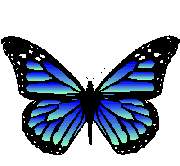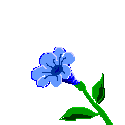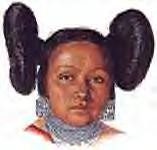|
|
Canku Ota - A Newsletter Celebrating Native America
March 25, 2000 - Issue 06
|
|

How the Butterflies Came to Be
Adapted by Vicki Lockard from a Papago Story

|
Now, one day after Earth-Maker shaped the world, Iioi, our Elder Brother
was sitting and watching the children play.
He saw the joy and the youthfulness they displayed.
He saw the beauty of their surroundings, and the fresh fragrance of the trees and the flowers.
He heard the happy songs of the birds, and saw the blue of the sky.
He saw the women as they ground cornmeal. He saw their beauty, and the sunlight as it shone from their hair.
These were wonderful things.

But then Elder Brother realized that all of these things would change.
He knew that these children would all grow old and weaken and die.
The beautiful women would someday grow fat and ugly, and their beautiful black hair would turn gray.
The leaves would turn brown and fall from the trees, and the beautiful flowers that smelled so fresh would fade.
The days would grow short and the nights would be cold.
Elder Brother's heart grew sad and troubled.

As Elder Brother watched the women grind cornmeal, the wind made some fallen yellow leaves dance in the sunlight.
He decided to do something which would capture some of these wonderful things which He saw.
He decided that He must make something that everyone could enjoy, that would lift their hearts and spirits.
So, He took out His bag of Creation and began to gather some things together.

He took some blue from the sky, and some whiteness from the cornmeal.
He gathered some spots of sunlight, and the blackness of a beautiful woman's hair.
He took the yellow of the falling leaves, and the green of the pine needles.
He gathered the red, the purple, and the orange from the flowers.
As He gathered these things, He put them into His bag.
And, last, He put the songs of the song birds in the bag.

When He had finished gathering these things together, He called the children together.
He told them to open the bag and there would be a surprise for them.
So they opened the bag, and out flew hundreds of beautiful Butterflies!
They were red and gold and black and yellow, blue and green and white.
They looked liked flowers, dancing in the wind.
They flew all around the gleeful children, and lit on their heads.
The hearts of the children and the adults soared.
Never before had they seen such wonderful, happy things.
They began to sing their songs as they flew.

But then song bird lit on Iitoi's shoulder and asked Him.
He said, "It is not right to give our songs to these pretty things!
You told us when you made us that each bird would have his own song.
These pretty things have all of the colors of the rainbow already.
Must they take our songs, too?"

Elder Brother said, "You are right.
I made one song for each bird, and I must not give them away to any other."
So butterflies were made silent, and they are still silent to this day.
But their beauty brightens the day of all People, and brings out songs from their hearts.
And that is how Elder Brother meant it to be.
The End
|
|

|
|
Discussion:
This beautiful gentle story unfolds as the flowers bloom and the children play happily during the time, of the
rain. Brilliant, colorful butterflies dancing in the wind, are created to dispel the feelings of sadness, aging,
and death. Seeing a butterfly lightens the hearts of children and brings gladness to those who have known life's
sorrows.
 Butterflies have always held a special place in the hearts of many Native American peoples.
Hopi girls of the butterfly clan, who had not yet married wore their hair styled in the shape of butterfly wings.
Many forms of pottery were, and still are, adorned with butterfly motifs. The word for butterfly among the Nez
Perce, of the Pacific Northwest is Lap Lap,
and their home is called Lapwai Valley. It is said the the butterflies came when the Nez Perce children called
to them. Butterflies have always held a special place in the hearts of many Native American peoples.
Hopi girls of the butterfly clan, who had not yet married wore their hair styled in the shape of butterfly wings.
Many forms of pottery were, and still are, adorned with butterfly motifs. The word for butterfly among the Nez
Perce, of the Pacific Northwest is Lap Lap,
and their home is called Lapwai Valley. It is said the the butterflies came when the Nez Perce children called
to them.
-
Print and color your own butterfly picture
Butterfly
Learn all about butterflies here
The Butterfly website
http://butterflywebsite.com/
|

|

|
Butterflies!
Need:
Clear Contact Paper
Handiwrap
Construction Paper
Small Pieces of Assorted Tissue Paper
Yarn
|

|
|
Cut the outline of a butterfly, outline should be about 1/4"to 1/2"wide. Place on clear contact paper.
Let child decorate interior of butterfly with assorted colored tissue paper (which will adhere easily to contact
paper). Place handiwrap over project. Cut around decorated butterfly. Make a hole at the top of butterfly and insert
yarn to hang up your spring butterfly. Great for very young children.

|
| |
|

|
Bright and Beautiful Butterflies
Need:
Two sheets of any color construction paper
one styrofoam ball ( 3 or 4 inch diameter or larger)
five colored pipe cleaners
a pencil or pen
two wood popsicle sticks
glue
assorted colored glitter
scissors
two small buttons or two craft "rolly" eyes
|

|
|
Draw butterfly wing shapes on each piece of colored construction,
making your wings as big or as small as you like. Decorate each wing by drawing a squiggly line with the glue and
then sprinkling glitter on top of the glue. Be as creative as you like! Set aside the wings and allow them to dry
completely.
Once the wings have dried, glue one wing onto one popsicle stick. Leave about one inch of the popsicle stick uncovered
from the wing. Let dry completely.
Glue rolly eyes or buttons or draw "eyes" on the styrofoam ball. Allow them to dry completely.
Holding the pen or pencil in one hand, wrap one pipe cleaner
around the pen or pencil, leaving one inch at the bottom uncoiled. Repeat with one more pipe cleaner. Insert pipe
cleaner "antenna" above eyes in styrofoam ball.
Cut remaining three pipe cleaners in equal halves. Insert pipe cleaner "legs" in two rows of three to
the underside of styrofoam ball, bending approximately one inch of the end pipe cleaner so as to create "feet."
Stick the uncovered ends of the popsicle sticks into the back of the styrofoam ball as to create your bright, beautiful
butterflies wings! Enjoy!
For extra fun, have the children color the styrofoam ball using magic markers before inserting anything in to it!
|
| |
|

|
| Canku Ota is a free Newsletter celebrating Native America, its traditions and accomplishments .
We do not provide subscriber or visitor names to anyone. Some articles presented in Canku Ota may contain copyright
material. We have received appropriate permissions for republishing any articles. Material appearing here is distributed
without profit or monetary gain to those who have expressed an interest. This is in accordance with Title 17 U.S.C.
section 107. |
| |
|
Canku Ota is a copyright of Vicki Lockard and Paul Barry.
|
| |
- The "Canku Ota - A Newsletter Celebrating Native America" web site
and its design is the Copyright © 1999 of Paul C. Barry. All Rights Reserved.
|







![]()
 Butterflies have always held a special place in the hearts of many Native American peoples.
Hopi girls of the butterfly clan, who had not yet married wore their hair styled in the shape of butterfly wings.
Many forms of pottery were, and still are, adorned with butterfly motifs. The word for butterfly among the Nez
Perce, of the Pacific Northwest is Lap Lap,
and their home is called Lapwai Valley. It is said the the butterflies came when the Nez Perce children called
to them.
Butterflies have always held a special place in the hearts of many Native American peoples.
Hopi girls of the butterfly clan, who had not yet married wore their hair styled in the shape of butterfly wings.
Many forms of pottery were, and still are, adorned with butterfly motifs. The word for butterfly among the Nez
Perce, of the Pacific Northwest is Lap Lap,
and their home is called Lapwai Valley. It is said the the butterflies came when the Nez Perce children called
to them.![]()
![]()


![]()


![]()